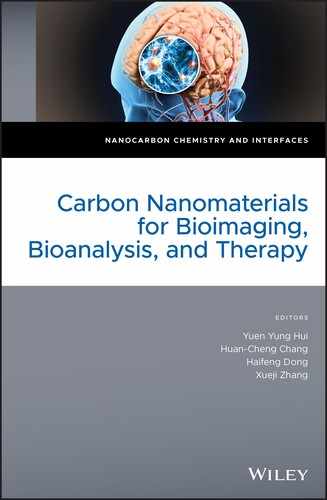Series Preface
Carbon, the sixth element in the periodic table, is extraordinary. It forms a variety of materials because of its ability to covalently bond with different orbital hybridizations. For millennia, there were only two known substances of pure carbon atoms: graphite and diamond. In the mid‐1980s, a soccer‐ball‐shaped buckminsterfullerene, namely a new carbon allotrope C60, was discovered. Together with later found fullerene‐structures (C70, C84), the nanocarbon researcher was spawned. In the early 1990s, carbon nanotubes were discovered. They are direct descendants of fullerenes and capped structures composed of 5‐ and 6‐membered rings. This was the next major advance in nanocarbon research. Due to their groundbreaking work on these fullerene materials, Curl, Kroto, and Smalley were awarded the 1996 Nobel Prize in chemistry. In the beginning of the 2000s, graphene was prepared, using Scotch tape. It is a single sheet of carbon atoms packed into a hexagonal lattice with a bond distance of 0.142 nm. For their seminal work with this new nanocarbon material, Geim and Novoselov were awarded the 2010 Nobel Prize in physics. As new members, carbon nanoparticles such as diamond nanoparticles, carbon dots, and graphene (quantum) dots have emerged in the family of nanocarbon materials. Although all these materials consist only of the same carbon atoms, their physical, chemical, and engineering features are different, which are fully dependent on their structures.
The purpose of this series is to bring together up‐to‐date accounts of recent developments and new findings in the field of nanocarbon chemistry and interfaces, one of the most important aspects of nanocarbon research. The carbon materials covered in this series include diamond, diamond nanoparticles, graphene, graphene‐oxide, graphene (quantum) dots, carbon nanotubes, carbon fibers, fullerenes, carbon dots, carbon composites, and their hybrids. The formation, structure, properties, and applications of these carbon materials are summarized. Their relevant applications in the fields of electroanalysis, biosensing, catalysis, electrosynthesis, energy storage and conversion, environment sensing and protection, biology, and medicine are highlighted in different books.
I certainly want to express my sincere thanks to Sarah Higginbotham, Jenny Cossham, Emma Strickland, and Lesley Jebaraj from Wiley. Without Sarah’s efficient help and valuable suggestions during this project, the publication of this book series would not have been possible. Last, but not least, I want to thank my family, especially my wife, Dr. Xiaoxia Wang and my children Zimo and Chuqian Luisa, for their constant and strong support as well as for their patience in letting me finalize such a book series.
Nianjun Yang
Series Editor
Siegen, Germany
